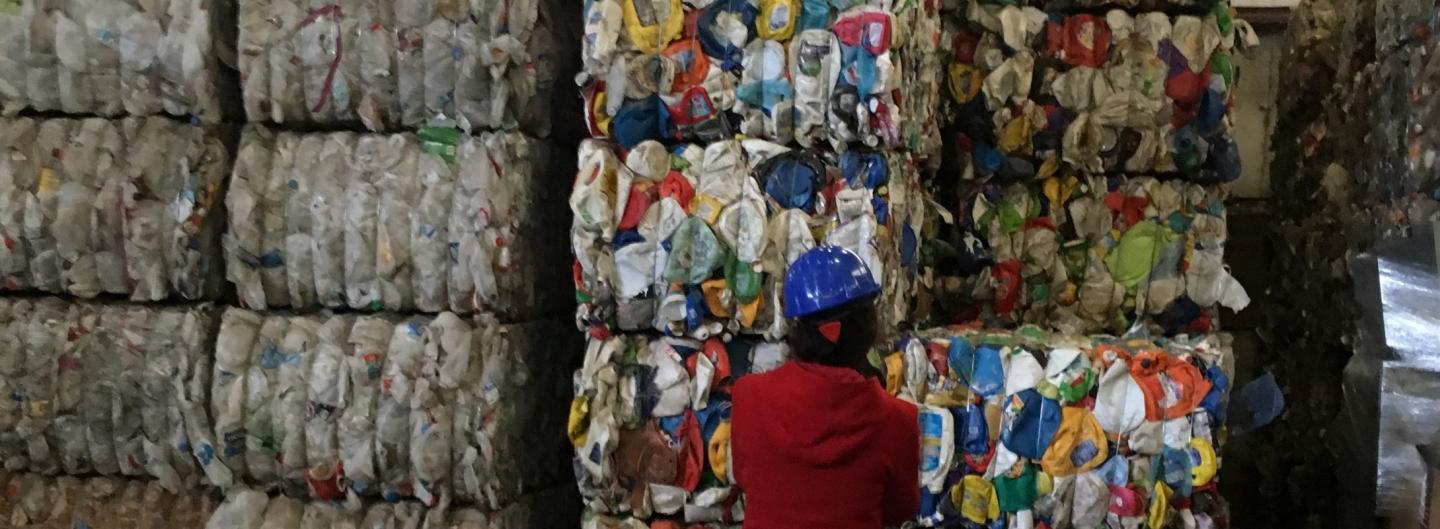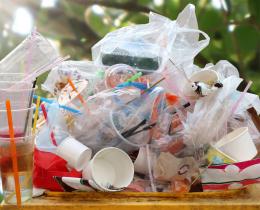When single-stream recycling debuted in the 1990s, it offered a simple solution to an increasingly complex problem. People could place all of their recyclable items in one bin, and somewhere along the way, everything would be sorted and reused.
Things have changed since then.
While the single-stream process is convenient, it also created a problem—contamination. One in four items placed in those bins cannot be recycled, either because it is made of a nonrecyclable material or because it is too soiled. A decade ago only about one in 15 items were contaminated.
Contamination also occurs through the unintended mixing of commodities during the mechanized sorting process. For instance, the plastic used in bottled water is much thinner now. When crushed, these plastics can be mistaken for paper by the sorting mechanisms.
The problem of contamination became readily apparent last year, when China began refusing certain types of recycled material and imposed strict quality standards on the rest. Now, Chinese inspectors, clipboards in hand, regularly tour recycling facilities to ensure the sorted commodities meet the new standards.
“They will walk around and pick out some bales (of sorted recyclables), put them on the floor, break the bales apart, and measure the contamination,” said Timothy Rose, executive director of the Ulster County Resource Recovery Agency in Kingston, N.Y. “And if there is any more than one half of one percent contamination, they won’t take any of it.”
Because China once accepted the largest portion of the world’s recycled material, its new policy, dubbed National Sword, has thoroughly disrupted recycling markets by drastically increasing recycling costs, and forcing the world to reconsider how it deals with waste.
And that includes us here at the Omega Institute.
In recent months, staff at the Omega Center for Sustainable Living has taken multiple tours of the nearby Ulster County materials recovery facility to learn about the new challenges and adapt our procedures to account for them.
“Yes, we’re interested in the potential to cut our trash and recycling costs, but our primary goal is to ensure a better outcome for our recyclables and the planet,” OCSL Director Laura Weiland said.
We’ve learned a lot, much of it surprising.
What We All Can Do
Though recycling policies vary in different localities, there are simple steps anyone can take to ensure less material ends up in landfills.
- Check with your hauler or local solid waste facility to understand what is accepted and what is not. Some facilities will accept and recycle milk cartons and other paper food containers that contain a waxy coating. But many others do not. At some facilities, black plastic is not accepted because optical sorters cannot read the codes.
- Empty and rinse out containers. At material recovery facilities, or MRFs as recycling facilities are called, conveyor belts move comingled materials past human sorters, optical sensors, and electromagnetic fields that lift tin and aluminum away from other materials. But one thing these complex mechanisms can’t do is get peanut butter out of a jar.
- Keep paper and cardboard dry. Cardboard recycling, in particular, is making a comeback in the United States, but wet fibers can disrupt that process.
- Do not engage in “wishful recycling.” Waste management officials use this term to describe the behavior of people who toss an item in a recycling bin with the hopes that it might be recycled somewhere down the line. Garden hoses are notorious contaminants that can become tangled inside the machinery at a MRF. So are thin, single-use plastic bags, though these can be recycled separately in places such as New York.
- Consider recycling potential when purchasing an item. Whereas plastic containers vary widely in type and post-use market value, an aluminum container can be sold, used, recovered, and back on a shelf in as few as six weeks. Demand for glass, on the other hand, is declining.
- Consider ways to lower the need for recycling by reducing, reusing, and repairing.
What Omega Is Doing
Here’s how we are reducing our waste and increasing recycling.
- Switching to dual-stream recycling. That means fiber—paper and cardboard—is separated from plastic, aluminum, tin, and glass, lowering the potential for contamination and reducing recycling costs, which had more than doubled using a single-stream system.
- Using compostable take-out containers. All take-out packaging—from containers to silverware to straws—is compostable. We coordinated this with our local composting facility to ensure that all materials could be accepted there.
- Creating new recycling signage to increase participation. New signage has been placed around campus and on bins to help our staff and participants recycle with less contamination.
Changes, such as China’s new policy, can cause painful disruptions in established recycling systems. But we can use them as an opportunity to reassess those systems and discover better alternatives.
We hope you'll join us.



